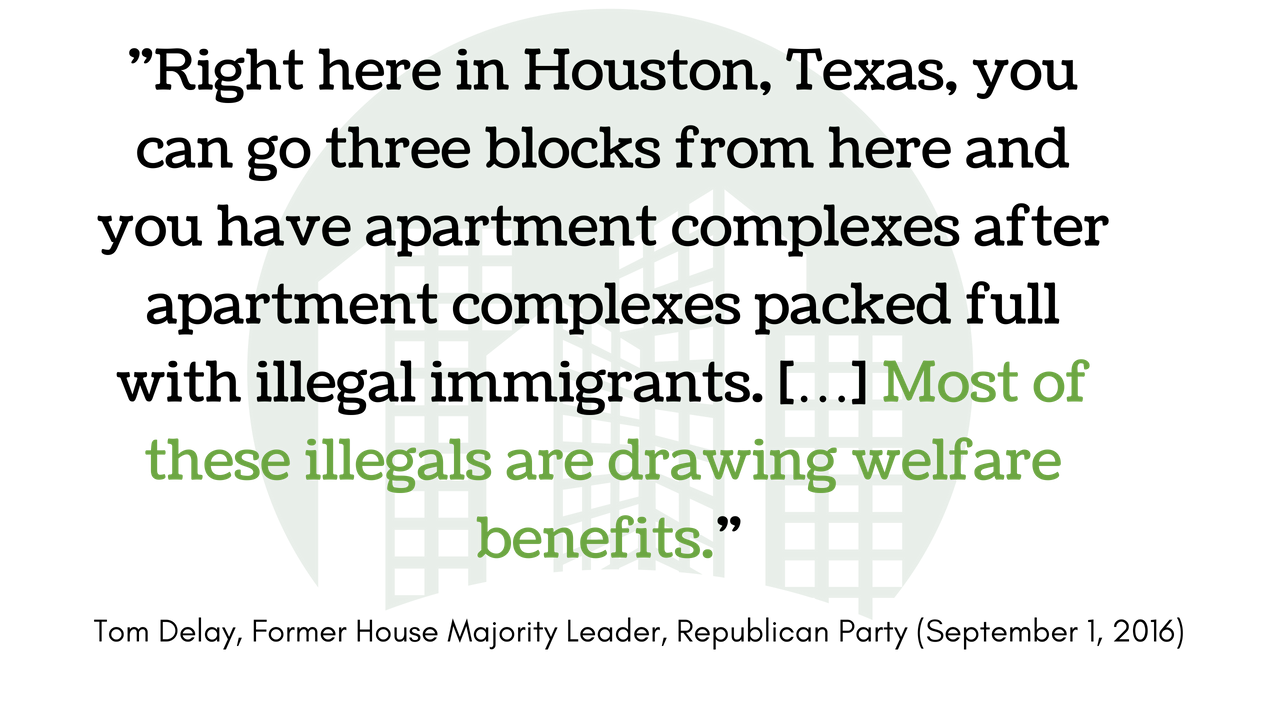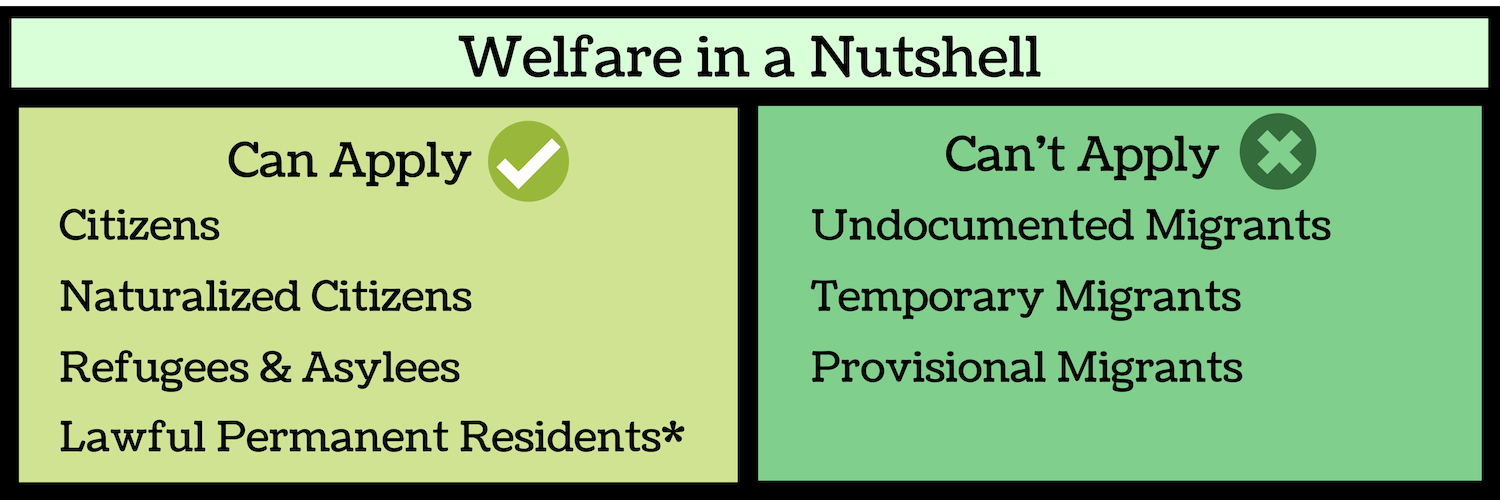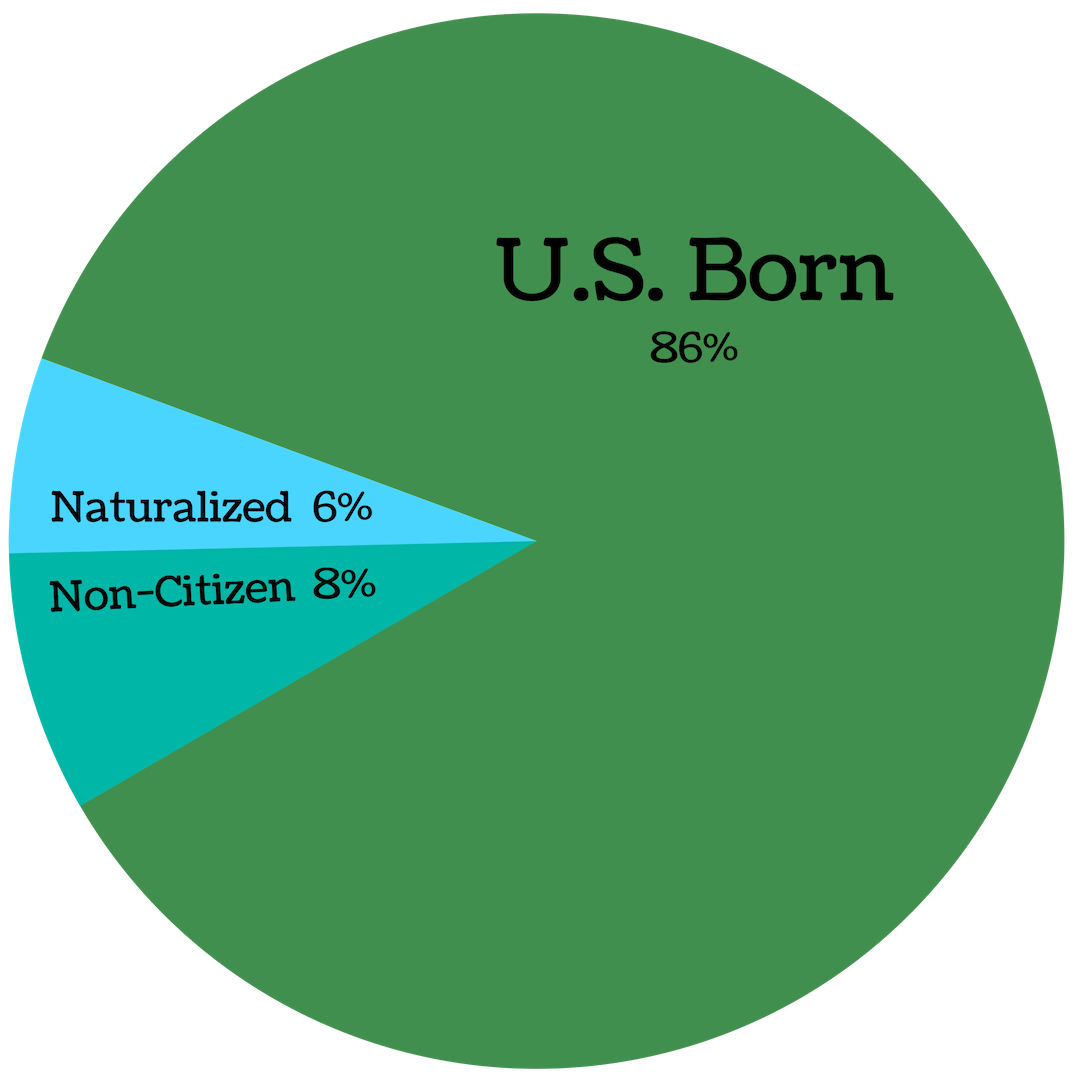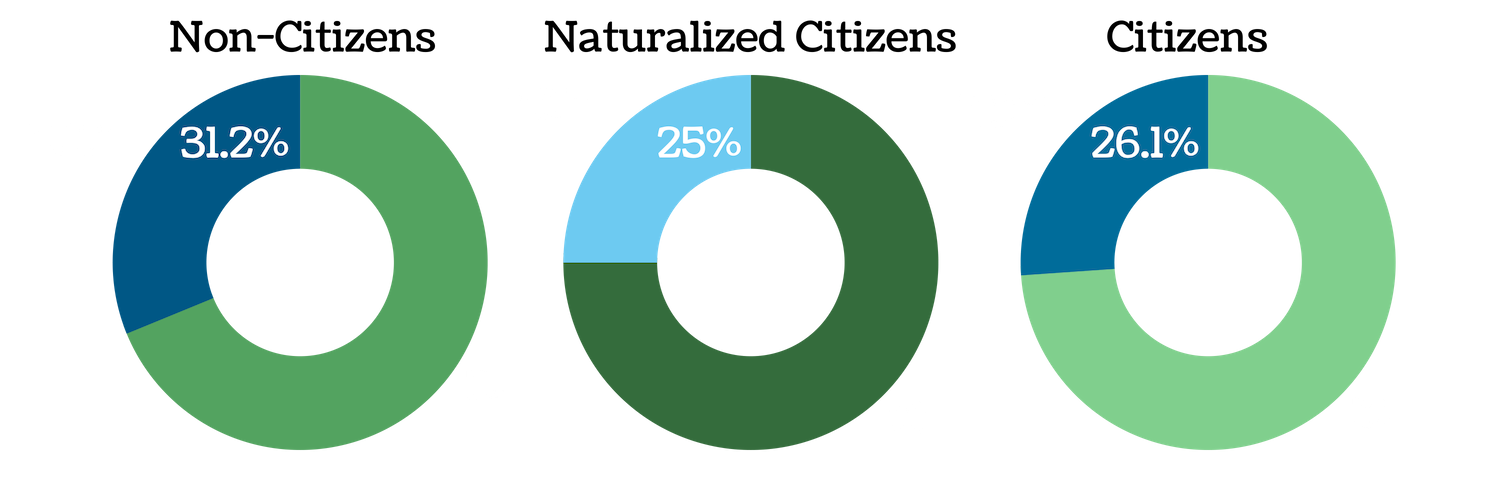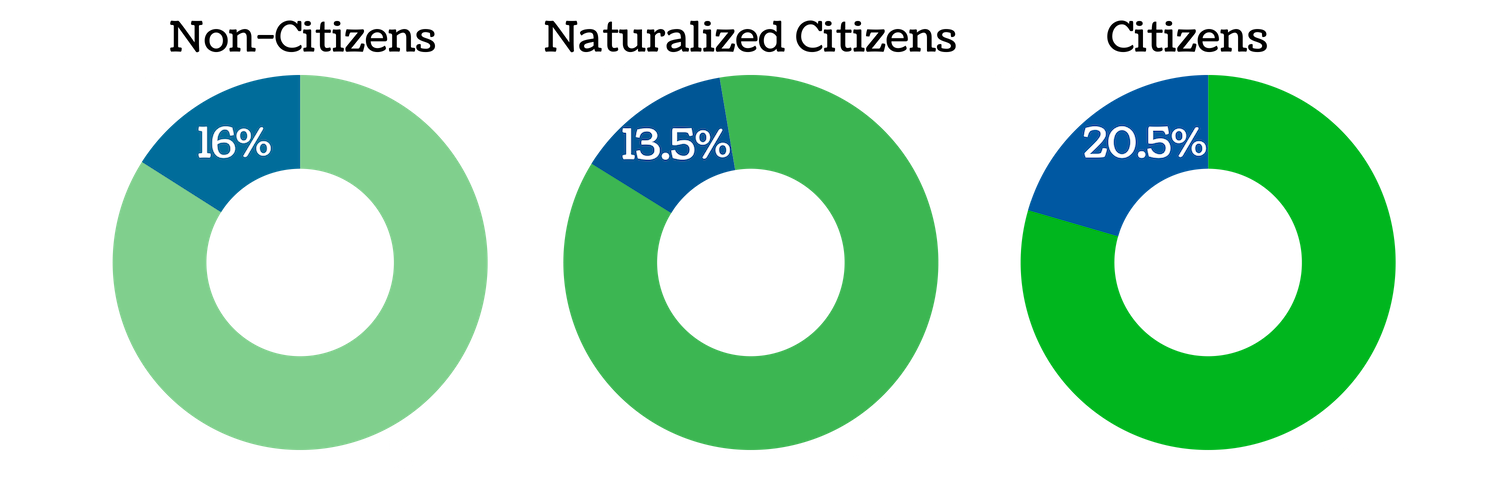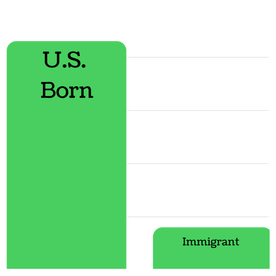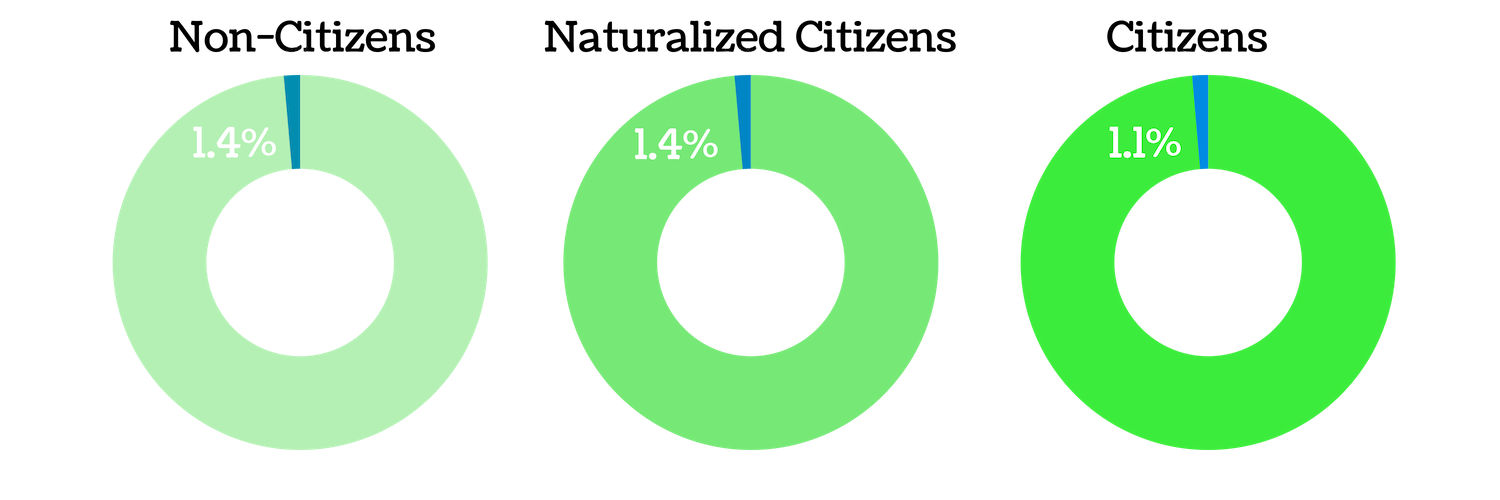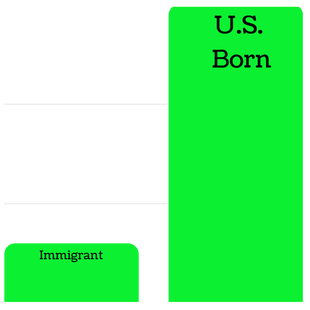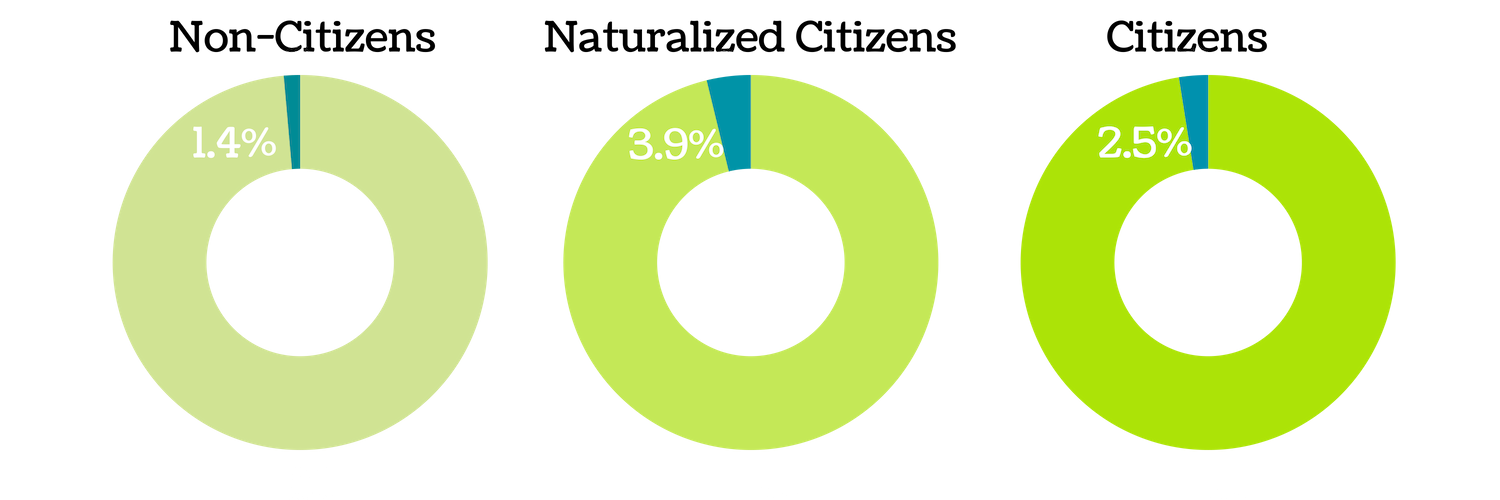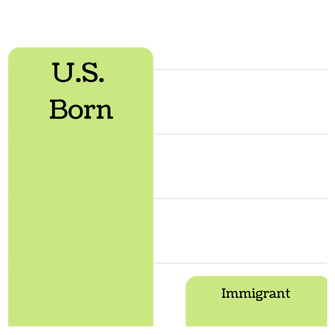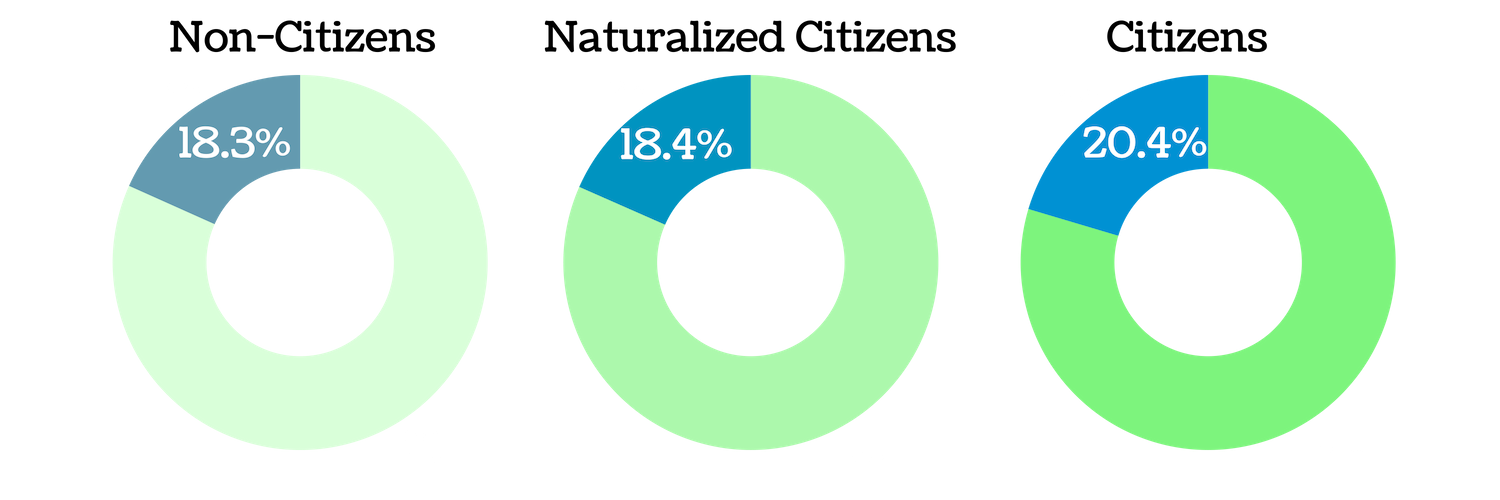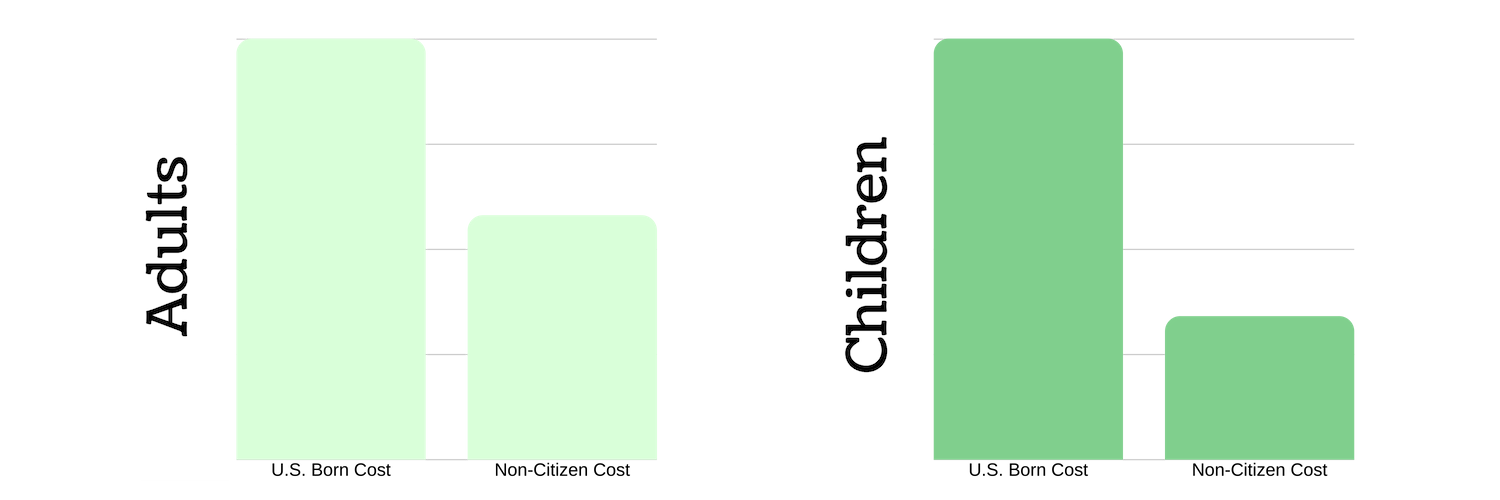Despite what many people think, the reality is that, illegal or not, most immigrants don’t actually qualify for public assistance programs.
The Personal Responsibility and Work Opportunity Reconciliation Act of 1996 (PRWORA) was one of the first policies to limit immigrant’s participation in public programs. [2] And, although it has been changed throughout the years [3] many of the policies outlined in that congressional act still stand.
So, who can receive public welfare benefits? [4][5]
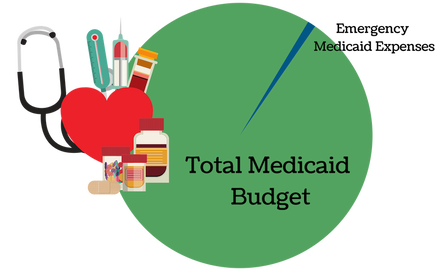
Citizens and Naturalized Citizens
All citizens have equal access to benefits as long as they qualify for the eligibility requirements. These include programs like Medicaid, the Children’s Health Insurance Program (CHIP), Supplemental Nutrition Assistance Program (SNAP, previously called food stamps), Temporary Assistance for Needy Families (TANF), and Supplemental Security Income (SSI).
Lawful Permanent Residents (LPRs)
Lawful permanent residents must be in the US for five years before they are eligible for benefits. However, states may provide benefits to some LPRs before the five-year wait period, and exceptions may be made for children and pregnant women to permit their access to SNAP and Medicaid even if they have not met the five year residency minimum.
Refugee and asylee status is a special exception. Refugees and asylees can receive most benefits as long as they fit the eligibility criteria.
Temporary/Provisional Immigrants
Temporary migrants, such as immigrants on a work or student visa, are unable to receive benefits from public programs. This also includes recipients of DACA (Deferred Action for Childhood Arrivals).
Undocumented Immigrants
Like temporary/provisional immigrants, immigrants without legal authorization to be in the US are unable to receive most welfare benefits. However, some states make permit some undocumented immigrants to receive emergency Medicaid. Overall, the cost of emergency Medicaid is estimated at 2 billion dollars annually, which is less than 1% of the total annual Medicaid budget. [6]
All citizens have equal access to benefits as long as they qualify for the eligibility requirements. These include programs like Medicaid, the Children’s Health Insurance Program (CHIP), Supplemental Nutrition Assistance Program (SNAP, previously called food stamps), Temporary Assistance for Needy Families (TANF), and Supplemental Security Income (SSI).
Lawful Permanent Residents (LPRs)
Lawful permanent residents must be in the US for five years before they are eligible for benefits. However, states may provide benefits to some LPRs before the five-year wait period, and exceptions may be made for children and pregnant women to permit their access to SNAP and Medicaid even if they have not met the five year residency minimum.
Refugee and asylee status is a special exception. Refugees and asylees can receive most benefits as long as they fit the eligibility criteria.
Temporary/Provisional Immigrants
Temporary migrants, such as immigrants on a work or student visa, are unable to receive benefits from public programs. This also includes recipients of DACA (Deferred Action for Childhood Arrivals).
Undocumented Immigrants
Like temporary/provisional immigrants, immigrants without legal authorization to be in the US are unable to receive most welfare benefits. However, some states make permit some undocumented immigrants to receive emergency Medicaid. Overall, the cost of emergency Medicaid is estimated at 2 billion dollars annually, which is less than 1% of the total annual Medicaid budget. [6]
Other State Exceptions to Federal Rules
Other exceptions involve programs for children. The National School Lunch program, for example, does not consider citizenship or immigrant status for eligibility, and neither do the Special Supplemental Nutrition Program for Women, Infants and Children (WIC) or Head Start. [7]
Other exceptions involve programs for children. The National School Lunch program, for example, does not consider citizenship or immigrant status for eligibility, and neither do the Special Supplemental Nutrition Program for Women, Infants and Children (WIC) or Head Start. [7]
To be clear, most immigrants cannot access federal social service benefits.
Medicare Recipients by Legal Status |
That's one of the reasons that they're less likely to receive welfare benefits than the U.S. born. However, some states permit immigrants to access certain state benefits. Given that most immigrants do not have access to federal welfare programs, they are actually more likely than natives to participate in state funded programs. [8][9]
Of these groups of immigrants who can actually receive welfare benefits, very few actually do. In fact, less immigrants use welfare programs than native-born Americans. [10] There are 82.6 million U.S. residents receiving one or more of the four main public benefits (SNAP, TANF, SSI, and Medicaid/CHIP). Of these residents, 70,669,200 (86%) are U.S. born citizens, 6,840,500 (8%) are not citizens, and 5,098,200 (6%) are naturalized citizens. [11] |
When considering welfare usage by percentage, immigrant use is about the same as native use. From 2014-2016 census bureau data, we can see that 31.2% of all non-citizens and 25% of naturalized citizens use one of the four main welfare programs. In contrast, 26.1% of U.S. born citizens use at least one of the four programs. [12]
Individual Immigrants and Welfare by Program
The following statistics are based on individual, not household, data from 2014-16. For example, if there are 2 immigrant parents and one naturalized citizen child in a household, because only the child is eligible for welfare benefits, only that child and not the two parents is represented in the data. [13]
The following statistics are based on individual, not household, data from 2014-16. For example, if there are 2 immigrant parents and one naturalized citizen child in a household, because only the child is eligible for welfare benefits, only that child and not the two parents is represented in the data. [13]
SNAP [14]
Food stamps are the only program where US-born citizens receive significantly less benefits by percentage than both naturalized and unnaturalized immigrants. The Migration Policy Institute estimates that 20.5% of non-citizens, 13.5% of naturalized citizens, and 16% of U.S. born citizens receive SNAP assistance.
|
TANF [15]
All groups receive about the same TANF, or cash assistance, by percentage. Both 1.4% of non-citizens and naturalized citizens receive TANF which is almost the same as the 1.1% of U.S. citizens who use TANF.
SSI [16]
In terms of percentage, naturalized citizens receive the most Supplemental Security income at 3.9% of all naturalized citizens. This is not much greater than the 2.5% of native born and 1.4% of noncitizen SSI recipients.
Medicaid/CHIP [17]
Percentage-wise, Medicaid is predominantly used by the U.S. born at 20.4% of the native population. Following close behind, 18.3% of non-citizens and 18.4% of naturalized citizens receive Medicaid or CHIP.
Overall, most immigrant usage of public programs is comparable to native usage of public programs
Plus, even when they receive benefits, the benefits that immigrants—both adults and children—receive cost less, which converts to less money expended by the US government. Take Medicaid for example. On average, non-citizen adults’ Medicaid costs 42% less than US-born adults’ Medicaid. For children, non-citizen children’s Medicaid costs 66% less than the cost of Medicaid for US citizen children born to US citizen parents. [18]
Medicaid Benefit Cost by Legal Status
But recently, the Center for Immigration Studies released a report stating the opposite. By looking at welfare use by household, they find that more households headed by immigrants use welfare programs than households headed by native-born Americans. [19]
Immigrants and Welfare Measured at the Household Level
|
Although the number of individual immigrants receiving welfare is relatively low, immigrant households can still receive benefits through citizen spouses and children. But it’s important to point out that in this study, an immigrant household is any household with a member who is an immigrant.
The reality is there are more non-citizens living in families receiving public benefits than there are actual non-citizens receiving benefits. [20] That’s why measuring benefit use by “immigrant household” can be misleading. It ignores the probability that the people receiving the benefits are likely to be U.S. born citizens—usually spouses or children of immigrants. But it’s not limited to just spouses and children. A household can include unmarried partners, grandparents, siblings, parents-in-law, siblings-in-law, children-in-law, roommates, boarders, and foster children. [21] As a result, an immigrant head of household could be taking the blame for anyone’s use of welfare benefits, even if they’re not really a part of their family. It’s especially unfair because, as we’ve already discussed, although some immigrants can receive public benefits, most can’t and don’t. |
Overall, 6.8 million individual non-citizens (31% of all non-citizens) use at least one of the four benefits whereas 10 million non-citizens live in families in a which a family member was receiving public benefits (47% of all non-citizens).
Still, even if immigrants did receive public benefits at the level that CIS tries to prove, many immigrants pay taxes that pay for those benefits whether they receive them or not. Undocumented immigrants especially, are likely to pay into a system without receiving the benefits of public programs like SSI. [22]
It's also interesting to note that, across the board, immigrant families are more likely to work while receiving benefits than native-born citizens. From 2014 to 2016, 58% of adult immigrants receiving welfare benefits were employed in contrast to the only 44% of employed U.S. born welfare recipients. [23]
On the whole, the information that’s available to us is clear:
1. Immigrants do not abuse the welfare system.
In fact, few immigrants qualify for public programs. Those that do use welfare, receive benefits at about the same rate as the US born and yet usually end up costing the government far less money than natives.
2. Immigrants may live in households with other people who receive benefits.
This use of welfare, however, meets the legal eligibility requirements and shouldn’t be considered abuse. Instead, it may be more reflective of immigrant assimilation. Want to learn more? Check out the culture and assimilation section here.
In fact, few immigrants qualify for public programs. Those that do use welfare, receive benefits at about the same rate as the US born and yet usually end up costing the government far less money than natives.
2. Immigrants may live in households with other people who receive benefits.
This use of welfare, however, meets the legal eligibility requirements and shouldn’t be considered abuse. Instead, it may be more reflective of immigrant assimilation. Want to learn more? Check out the culture and assimilation section here.
Sources:
Sources Referenced on this Page:
[1] Quote from: https://www.politifact.com/texas/statements/2016/sep/28/tom-delay/tom-delay-says-most-illegal-immigrants-draw-welfar/; https://www.politifact.com/personalities/tom-delay/
[2] See this article from The Migration Policy Institute: https://www.migrationpolicy.org/article/immigrants-and-welfare-use
[3] See this article from The Migration Policy Institute: https://www.migrationpolicy.org/article/immigrants-welfare-reform-and-coming-reauthorization-vote
[4] Most of the information from this section comes from page 4 of this report by the CATO institute: https://object.cato.org/sites/cato.org/files/pubs/pdf/workingpaper-13_1.pdf. For a shorter summary of the same report see this link: https://www.cato.org/publications/economic-development-bulletin/poor-immigrants-use-public-benefits-lower-rate-poor
[5] The same information can also be found here: https://aspe.hhs.gov/basic-report/overview-immigrants-eligibility-snap-tanf-medicaid-and-chip
[6] See this guest article from Tara Watson of Williams College at: https://econofact.org/do-undocumented-immigrants-overuse-government-benefits
[7] See this guest article from Tara Watson of Williams College at: https://econofact.org/do-undocumented-immigrants-overuse-government-benefits and also this article from CATO: https://www.cato.org/publications/economic-development-bulletin/poor-immigrants-use-public-benefits-lower-rate-poor
[8] See this guest article from Tara Watson of Williams College at: https://econofact.org/do-undocumented-immigrants-overuse-government-benefits
[9] See https://aspe.hhs.gov/basic-report/overview-immigrants-eligibility-snap-tanf-medicaid-and-chip
[10] See the summary of the full article from CATO: https://www.cato.org/publications/economic-development-bulletin/poor-immigrants-use-public-benefits-lower-rate-poor
[11] See page 18 of this MPI report. Download the full report here: https://www.migrationpolicy.org/research/chilling-effects-expected-public-charge-rule-impact-legal-immigrant-families
[12] See page 19, Table 2 of this MPI report. Download the full report here: https://www.migrationpolicy.org/research/chilling-effects-expected-public-charge-rule-impact-legal-immigrant-families
[13] Older data from 2011 can be found here from the CATO institute
[14] See page 21, Table 3 of this MPI report. Download the full report here: https://www.migrationpolicy.org/research/chilling-effects-expected-public-charge-rule-impact-legal-immigrant-families
[15] See page 21, Table 3 of this MPI report. Download the full report here: https://www.migrationpolicy.org/research/chilling-effects-expected-public-charge-rule-impact-legal-immigrant-families
[16] See page 21, Table 3 of this MPI report. Download the full report here: https://www.migrationpolicy.org/research/chilling-effects-expected-public-charge-rule-impact-legal-immigrant-families
[17] See page 21, Table 3 of this MPI report. Download the full report here: https://www.migrationpolicy.org/research/chilling-effects-expected-public-charge-rule-impact-legal-immigrant-families
[18] See this working paper from CATO: https://object.cato.org/sites/cato.org/files/pubs/pdf/workingpaper-13_1.pdf
[19] Find the full report here: https://cis.org/Report/Welfare-Use-Legal-and-Illegal-Immigrant-Households
[20] See page 19 of this MPI report. Download the full report here: https://www.migrationpolicy.org/research/chilling-effects-expected-public-charge-rule-impact-legal-immigrant-families
[21] See page 19, table 2 notes of this MPI report. Download the full report here: https://www.migrationpolicy.org/research/chilling-effects-expected-public-charge-rule-impact-legal-immigrant-families
[22] See this guest article from Tara Watson of Williams College at: https://econofact.org/do-undocumented-immigrants-overuse-government-benefits
[23] See page 4 of this MPI report. Download the full report here: https://www.migrationpolicy.org/research/chilling-effects-expected-public-charge-rule-impact-legal-immigrant-families
[1] Quote from: https://www.politifact.com/texas/statements/2016/sep/28/tom-delay/tom-delay-says-most-illegal-immigrants-draw-welfar/; https://www.politifact.com/personalities/tom-delay/
[2] See this article from The Migration Policy Institute: https://www.migrationpolicy.org/article/immigrants-and-welfare-use
[3] See this article from The Migration Policy Institute: https://www.migrationpolicy.org/article/immigrants-welfare-reform-and-coming-reauthorization-vote
[4] Most of the information from this section comes from page 4 of this report by the CATO institute: https://object.cato.org/sites/cato.org/files/pubs/pdf/workingpaper-13_1.pdf. For a shorter summary of the same report see this link: https://www.cato.org/publications/economic-development-bulletin/poor-immigrants-use-public-benefits-lower-rate-poor
[5] The same information can also be found here: https://aspe.hhs.gov/basic-report/overview-immigrants-eligibility-snap-tanf-medicaid-and-chip
[6] See this guest article from Tara Watson of Williams College at: https://econofact.org/do-undocumented-immigrants-overuse-government-benefits
[7] See this guest article from Tara Watson of Williams College at: https://econofact.org/do-undocumented-immigrants-overuse-government-benefits and also this article from CATO: https://www.cato.org/publications/economic-development-bulletin/poor-immigrants-use-public-benefits-lower-rate-poor
[8] See this guest article from Tara Watson of Williams College at: https://econofact.org/do-undocumented-immigrants-overuse-government-benefits
[9] See https://aspe.hhs.gov/basic-report/overview-immigrants-eligibility-snap-tanf-medicaid-and-chip
[10] See the summary of the full article from CATO: https://www.cato.org/publications/economic-development-bulletin/poor-immigrants-use-public-benefits-lower-rate-poor
[11] See page 18 of this MPI report. Download the full report here: https://www.migrationpolicy.org/research/chilling-effects-expected-public-charge-rule-impact-legal-immigrant-families
[12] See page 19, Table 2 of this MPI report. Download the full report here: https://www.migrationpolicy.org/research/chilling-effects-expected-public-charge-rule-impact-legal-immigrant-families
[13] Older data from 2011 can be found here from the CATO institute
[14] See page 21, Table 3 of this MPI report. Download the full report here: https://www.migrationpolicy.org/research/chilling-effects-expected-public-charge-rule-impact-legal-immigrant-families
[15] See page 21, Table 3 of this MPI report. Download the full report here: https://www.migrationpolicy.org/research/chilling-effects-expected-public-charge-rule-impact-legal-immigrant-families
[16] See page 21, Table 3 of this MPI report. Download the full report here: https://www.migrationpolicy.org/research/chilling-effects-expected-public-charge-rule-impact-legal-immigrant-families
[17] See page 21, Table 3 of this MPI report. Download the full report here: https://www.migrationpolicy.org/research/chilling-effects-expected-public-charge-rule-impact-legal-immigrant-families
[18] See this working paper from CATO: https://object.cato.org/sites/cato.org/files/pubs/pdf/workingpaper-13_1.pdf
[19] Find the full report here: https://cis.org/Report/Welfare-Use-Legal-and-Illegal-Immigrant-Households
[20] See page 19 of this MPI report. Download the full report here: https://www.migrationpolicy.org/research/chilling-effects-expected-public-charge-rule-impact-legal-immigrant-families
[21] See page 19, table 2 notes of this MPI report. Download the full report here: https://www.migrationpolicy.org/research/chilling-effects-expected-public-charge-rule-impact-legal-immigrant-families
[22] See this guest article from Tara Watson of Williams College at: https://econofact.org/do-undocumented-immigrants-overuse-government-benefits
[23] See page 4 of this MPI report. Download the full report here: https://www.migrationpolicy.org/research/chilling-effects-expected-public-charge-rule-impact-legal-immigrant-families
